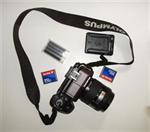Digital Camera Technology
DIGITAL CAMERAS
 A still camera that records images in digital form. Unlike traditional analogue cameras that record infinitely variable intensities of light, digital cameras record discrete numbers for storage on a flash memory card or optical disk. As with all digital devices, there is a fixed, maximum resolution and number of colours that can be represented. Images are transferred to the computer with a USB cable or via the memory card. Digital video cameras also use FireWire.
A still camera that records images in digital form. Unlike traditional analogue cameras that record infinitely variable intensities of light, digital cameras record discrete numbers for storage on a flash memory card or optical disk. As with all digital devices, there is a fixed, maximum resolution and number of colours that can be represented. Images are transferred to the computer with a USB cable or via the memory card. Digital video cameras also use FireWire.
Digital Advantages
There are two distinct advantages of digital cameras. The first is being able to see the final image right away so you know you have the picture you wanted. Bad pictures can be instantly erased. The second is convenience. You can take one picture and print it without waiting to develop an entire roll of film or wasting the whole roll for just a few pictures. In addition, "digital film" is reusable, except for the write-once optical disc (CD-R) variety.
Chips and Flash
The film in a digital camera is made up of photosensor chips and flash memory. The camera records colour images as intensities of red, green and blue, which are stored as variable charges on a CCD or CMOS image sensor chip. The charges, which are actually analogue, are converted to digital and stored in one of several flash memory formats such as CompactFlash or Memory Stick. Instead of memory cards, some still cameras use optical disc for storage, and video cameras may use discs or tape (see DV).
The size of the chip determines the resolution, but the analogue-to-digital converter (ADC), which converts the charges to digital data, determines the colour depth. In 2002, Foveon introduced a breakthrough in colour accuracy with its X3 CMOS chip (see Bayer pattern and X3).
Digital video cameras also use these same image sensing methods, but may also output traditional analogue signals (NTSC) in addition to digital. See flash memory, photo editor, photo scanner, X3 and DSLR.
Major Features
Following are the major features and some caveats of digital cameras.
- Resolution in Megapixels
The number of pixels determines the maximum size of a printed photo without sacrificing quality. For 3x5" and 4x6" prints, 2 megapixels is good. For 5x7" and 8x10" prints, 5 megapixels is preferred. For low-resolution images on the Web, almost any digital camera will suffice. However, you can easily reduce a high-quality image to the low resolution required online. The higher the resolution from the start, the better the results.
- Optical Quality
Megapixel resolution is a quantitative measurement, but the lens itself is qualitative. The optical quality of the lens greatly contributes to the resulting picture quality as it has in analogue cameras for more than a century. To make a decision on this one, the printed pictures have to be seen.
- Optical vs. Digital (Interpolated) Zoom
The optical zoom is the real resolution of the lenses. The digital zoom is an interpolated resolution computed by software. The higher the optical number, the better. A 10x optical is far superior to a 10x digital. Some digital zoom numbers go into the stratosphere, especially for video, but optical is what counts.
- Storage Media
There are several types of flash memory cards used for "digital film," but no matter which type the camera uses, the one that comes with the camera is typically undersized. Plan on purchasing a larger one when you buy the camera (see flash memory).
- Data Transfer
Digital cameras come with a USB cable for transfer directly to the computer, and many computers come with one or more memory card slots. Printers may also come with card slots, allowing you to print your photos without using the computer at all.
- Battery Duration
Digital cameras use either rechargeable or standard AA batteries. It can take an hour or more to recharge a battery, so an extra one, fully charged, is always a good idea to have along. AA batteries can be purchased almost anywhere, and rechargeable AA batteries can also be used.
- Interchangeable Lenses
Digital single lens reflex (DSLR) cameras are the digital counterparts of their analog predecessors and may use the same removable lenses that you already own. However, the chip is often smaller in size than a 35mm frame, which means your 28mm wide angle lens may function like a 42mm lens. Increasingly larger chips and wider angle lenses are solving the problem.
Learning More
[02/01/2026 09:47:04]